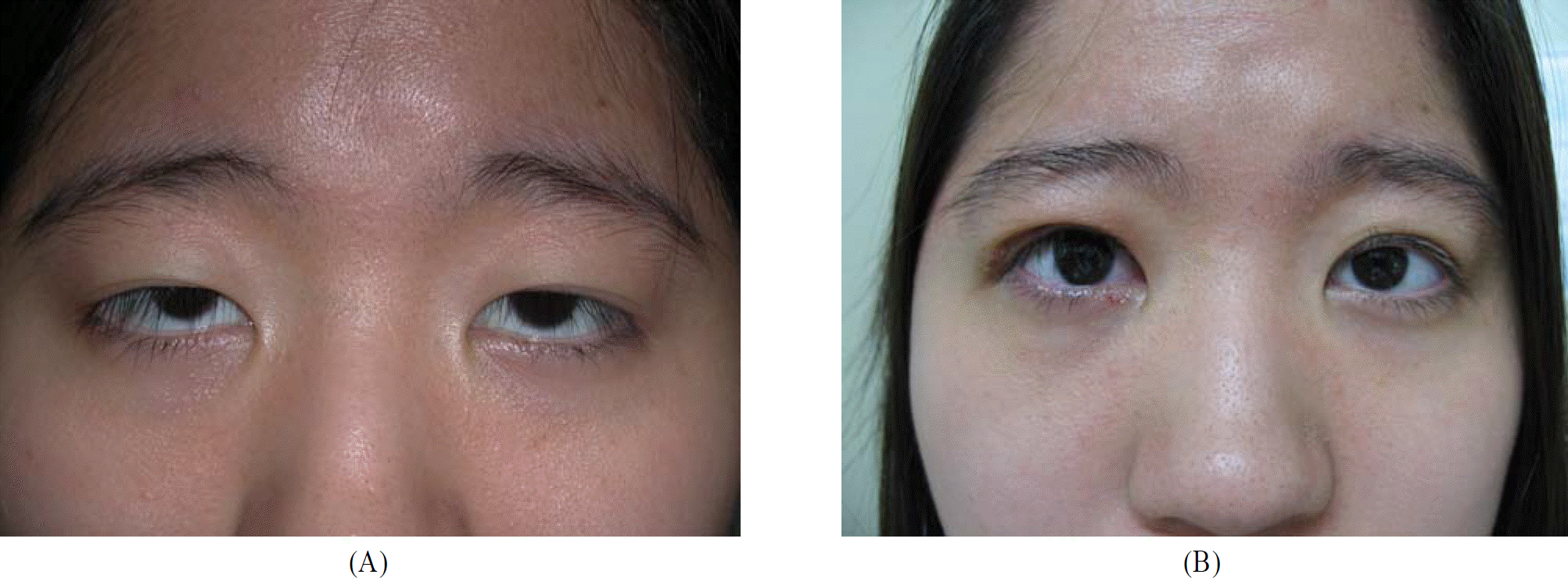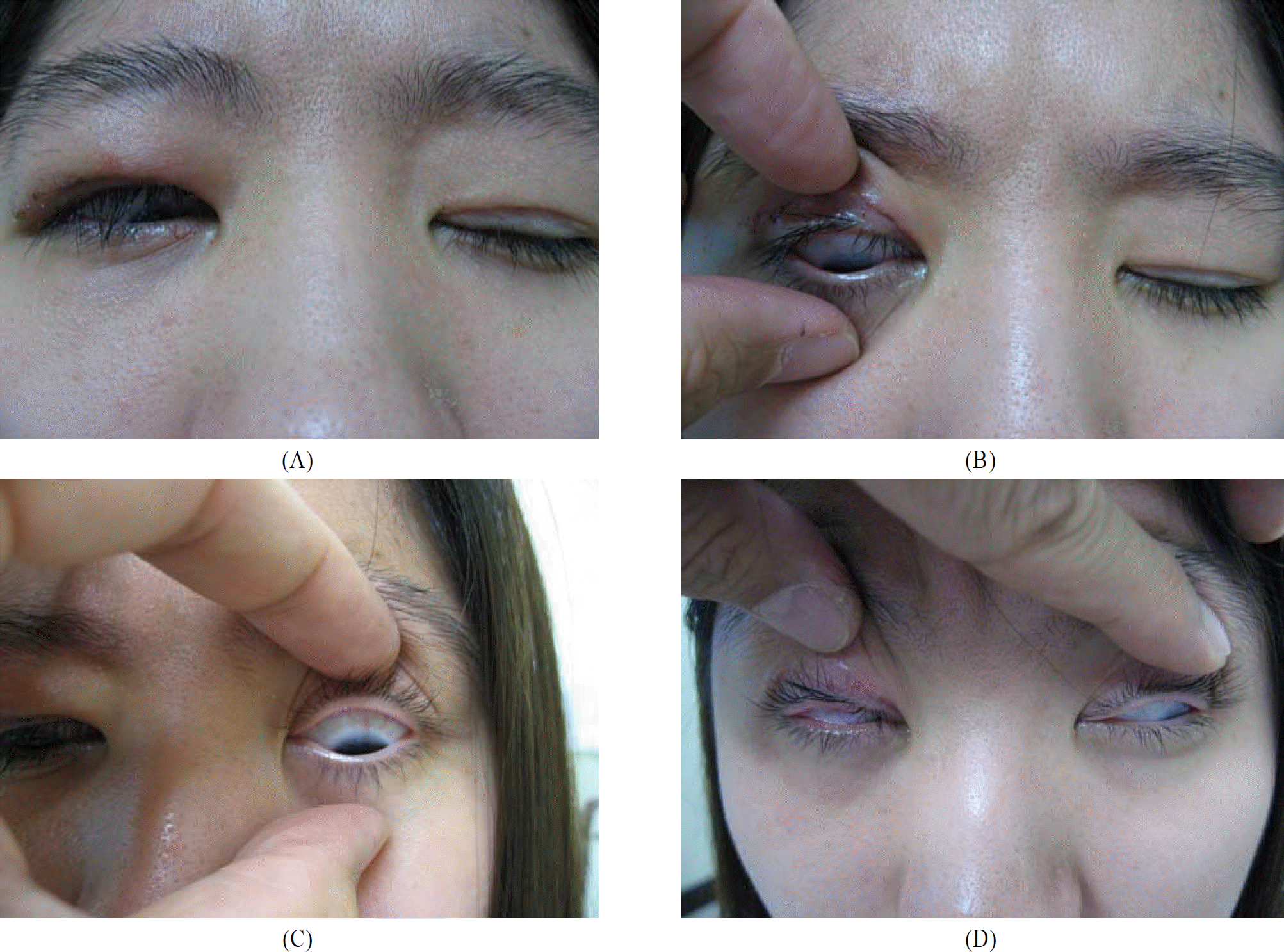Abstract
Purpose
We report a complication involving a transient inversion of Bell's phenomenon observed following extensive levator resection performed to treat aponeurotic ptosis.
Case summary
A 22 year old female patient complained of ptosis of both eyelid. The levator function of both lid was good, and a normal corneal protection mechanism was observed. The patient underwent levator resection and several reoperation because of asymmetrical lid height and entropion. Inversion of Bell's phenomenon was observed in the postoperative period. Eye with Bell's phenomenon reverted to normal within 1 month after final operation, and there were no corneal erosion. Lubricating eyedrop was used frequently during the postoperative period.
References
1. Fasanella RM, Servat J. Levator resection for minimal ptosis: another simplified operation. Arch Ophthalmol. 1961; 65:493–6.

2. Putterman AM, Urist MJ. Muller muscle-conjunctiva resection. Technique for treatment of blepharoptosis. Arch Ophthalmol. 1975; 93:619–23.
3. Berke RN. Results of resection of the levator muscle through a skin incision in congenital ptosis. AMA Arch Ophthalmol. 1959; 61:177–201.

4. Crawford JS. Repair of ptosis using frontalis muscle and fascia lata. Trans Am Acad Ophthalmol Otolaryngol. 1956; 60:672–8.
5. Callahan A. Correction of unilateral blepharoptosis with bilateral eyelid suspension. Am J Ophthalmol. 1972; 74:321–6.

6. Bell C. On the motion of the eye in illustration of the uses of the muscles and nerves of the orbit. Philos Trans R Soc Lond. 1823; 113:166–86.
8. Hiraoka M. Physiological study of the Bell's phenomenon in human. Nippon Ganka Gakkai Zasshi. 1979; 83:2184–90.
9. Ferrer JA. Conclusions from Bell's phenomenon variants. Trans Am Acad Ophthalmol Otolaryngol. 1973; 77:714–20.
10. Snir M, Kremer I, Kuperman A, et al. Bell's phenomenon in newborns and premature babies. Br J Ophthalmol. 1996; 80:553–5.

11. Hall AJ. Some observations on the acts of closing and opening the eyes. Br J Ophthalmol. 1936; 20:257–95.

12. Francis IC, Loughhead JA. Bell's phenomenon. A study of 508 patients. Aust J Ophthalmol. 1984; 12:15–21.
14. Collewijn H, van der Steen J, Steinman RM. Human eye movements associated with blinks and prolonged eyelid closure. J Neurophysiol. 1985; 54:11–27.

15. Gupta JS, Chatterjee A, Kumar K. Inverse bell's phenomenon as a protective mechanism. Am J Ophthalmol. 1965; 59:931–3.
16. Betharia SM, Kalra BR. Observations on Bell's phenomenon after levator surgery. Indian J Ophthalmol. 1985; 33:109–11.
17. Betharia SM, Sharma V. Inverse Bell's phenomenon observed following levator resection for blepharoptosis. Graefes Arch Clin Exp Ophthalmol. 2006; 244:868–70.

18. Lisch K. Bell's phenomenon. Klin Monatsblatter Augenheilkd Augenarztl Fortbild. 1954; 125:710–5.
19. Kim HM, Lee TS. Clinical observation and their surgical result of 127 cases of blepharoptosis. J Korean Ophthalmol Soc. 1985; 26:441–8.
20. Baek SH, Kim YD. Hard palate mucosa grafts for cicatricial entropion. J Korean Ophthalmol Soc. 1996; 37:541–8.
Figure 1.
(A) Preoperative view of a 22-year-old female patient with bilateral aponeurotic ptosis with good levator function measured 12 mm. (B) One month following final surgery. Postoperpative photograph showing satisfactory lid height in the primary gaze of both eyes.

Figure 2.
(A) Postoperative view of a patient immediately after suture removal following the third levator resection in the right eye and the second operation in the left eye showing inverse Bell's phenomenon on eye closure. The lagophthalmos in the right eye enables observation of the inversion of Bell's phenomenon. (B), (C), (D) Both eyeballs roll downward on attempted voluntary eyelid closure against resistance.





 PDF
PDF ePub
ePub Citation
Citation Print
Print


 XML Download
XML Download